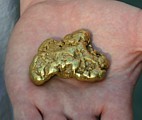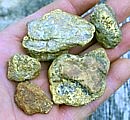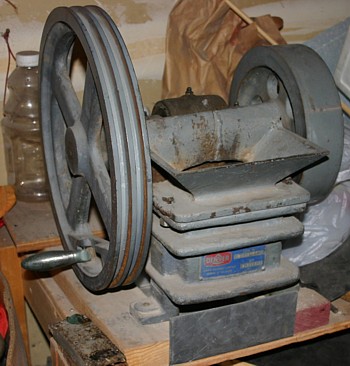
.

|
|
 |
||
|
. |
Want to get all the gold out of your black sands? There is often some very small sized gold there and it can be a lot of work to get all the gold out. We work hard to capture the gold and we don't want to throw the fine gold away as it can be valuable. There are a lot of different options, and in the article below I'll take a look at all of the best known possibilities for getting the gold and other valuable minerals out of your black sands and producing a clean, saleable placer gold product. Take a look at the following information....... |
 |
|
Sometimes with high grade gold specimens, you have to crush your ore to recover it's gold.....
| Gold is often found associated with the mineral quartz. It is sometimes associated with other minerals as well, including iron and manganese oxides, calcite, pyrite and other sulfides as well. It is not uncommon for prospectors, especially those who operate metal detectors, to find a rich gold bearing specimens of ore. Sometimes the best use of these minerals is to sell them at specimens. There are collectors who will pay top dollar for beautiful mineral specimens that contain significant gold. I have done a full webpage to discuss the best ways of getting top dollar for specimens and selling to collectors. (Selling your gold) Some specimens however, especially those with a large amount of rock and only a limited amount of gold are best crushed and the gold extracted and sold to refiner (information about selling to refiners can also be found on my gold selling page). Here is a discussion of the procedures to crush Quartz or other minerals and extract the gold from these rich ores. | ||
| For really large chunks of material, it may be necessary to initially
break down the large pieces with hammers. Sometimes heavy-duty chisels can also come
in handy in this part of the process as one breaks down large chunks into fist sized and
smaller pieces that can be more easily handled. The classic old mortar and pestle was the method used by early day miners to crush their ore specimens for testing. You can still buy these things today at most prospecting stores - they are made of cast iron and last a long time and work fairly well. It just takes a lot of elbow grease and work to break up the rock. A slightly different version of mortar and pestle work is a variety called hand stamp crushing. A heavy cylinder of iron is welded to a long rod and placed inside a pipe or tube which is just a bit larger than the diameter of the iron cylinder. This iron cylinder is picked up and dropped onto the ore, much in the manner of the old time stamp mills. This method seems to be popular in Australia. A more expensive but certainly faster and easier method is to use a small jaw crusher, such as is used in preparing samples for assaying. I have one of these in my garage and it is pictured at the right. For those thinking about processing larger quantities of ore such as hundreds or even thousands of pounds of rock from mines, there are several manufacturers that sell small portable hammer and impact mills. These mechanized crushing systems can generate some very significant dust, and so when using them is important to consider methods for dust control or elimination. |
 |
|
| No matter which crushing system you're using, the process
will go far faster, and come out better if you do repeated screenings of the material from
time to time. What happens in crushing is that some of the material gets crushed down to
the size you want but other pieces don't. The small stuff then often gets in the way
of the crushing process as you are working, basically protecting the larger pieces from
being crushed and creating more work. To speed things up and make things work
properly you need to screen out the stuff that's already been crushed to a small size. So
as you are crushing, stop and screen your material, removing any free gold which has
already separated from the rock during your crushing that won't go through your screen
with your fingers. The coarser rock that won't go through your screen can then be
returned to the crusher for further work to break it down, and the fines won't get in the
way. If you're screaming of course you need to pick out the screen size you're going to use. It is really not necessary to go to super small screens like 100 mesh. This reduces most of your rock quite literally to powder. The size of screen I use is 18 mesh and I think anything in the range of 16 to 20 mesh is a good size. I would not recommend going with anything larger than 10 mesh or smaller than 30. |
||
Finally, once the rock is fully crushed we get to the part about separating out the gold from the crushed rock. Often, this is accomplished simply by very careful panning. Panning is the most suitable method if you only have an amount of rock less than about 15 or 20 pounds. On the other hand if you are going to be processing large quantities of rock on a regular basis such as would come from the workings of a hard rock mine, you will need some sort of automated system to process your crushed materials. If you really are going to be working with ores from a hard rock mine, perhaps the best method for the small minor is the use of the a small shaking table. A good table is fairly bulletproof in one set up operates well on its own, and does an efficient job of capturing small gold particles. Such equipment isn't cheap of coarse but if you're going to be handling thousands of pounds of rock, it's just too much to consider panning as an option for processing. Another possibility that needs to be considered is the use of mercury in capturing the finest gold particles from your ores. In most instances if you are just handling a few gold Quartz specimens that you find here and there, the use of mercury will not be worth your time. In some cases the gold in the ore is extremely fine sized, and using mercury to capture it makes sense. This is also true for operators processing large quantities of hard rock material. I've done up a web page on using Mercury to capture fine gold and you can view it here. (link to page) |
 |
|
| For handling another purpose as many operators
will be interested in melting down the gold
they recover in crushing their specimens into dore buttons and bars (Dore is a term for
unrefined, impure gold and silver metal). I've done up a web
page on melting and pouring your gold and you can view it here. (Pouring Your Own
Gold)
It is
also important to consider safety precautions when crushing ores. These
include: Ø Eye protection. it is normal that one crushing rock small particles fly through the air. If a small sharp piece of quartz lands in your eye, it could do some serious damage. It is important to always wear goggles or protective glasses when crushing. Goggles are the better choice of the two. Ø Dust mask: the process of crushing rock always creates airborne dust. If your lungs are already compromised by smoking or other problems, you definitely don't want to expose them to additional hazards. Silicosis is a very nasty and incurable problem which is brought on by long-term exposure to quartz bearing dust. Using a dust mask when crushing is a good habit and make sense especially if you're doing it a regular basis. Ø Gloves are also a good safety measure to protect your hands. I always use them. Ø If using mechanized equipment, always be very careful around any moving parts. A good number of accidents in the mining industry occur when people get hands or clothing caught in moving mechanized parts. The precautions you take will be well worth your time. If you would like to consider building your own hand operated rock crusher, check out the possibilities on my web page at: Build Your Own Rock Crusher |
||
Want to know a little bit more about this crazy prospector guy? Well, here's a little bit more about me, and how I got into prospecting: Chris' Prospecting Story Interested in seeing more gold? Here are some interesting photos of beautiful Gold Nuggets